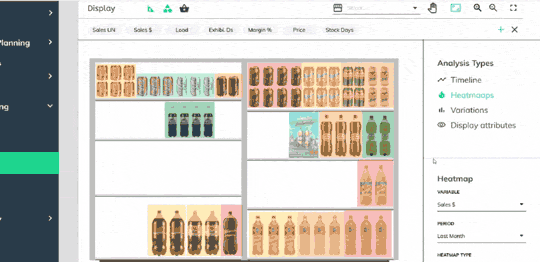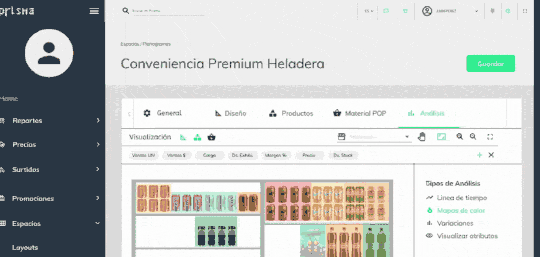Planograms: the importance of Retail Space Planning
- In the following blog post, we will discuss the role of planograms in retail space optimization.
- For decades, Planograms have been the primary approach to retail planning to design stores that positively influence customers’ shopping experience. From small retailers that create planograms manually to maximize their selling space or simply use their intuition, to the most significant U.S. retail chains, such as Walmart and Target that automate planograms to create consistent experiences across stores, improve visual appeal and optimize product or category placement.
- However, as more and more retailers are discovering, the process of planogram creation is not up to today's ever-changing operations where: changes and adjustments abound, promotions occur daily, and teams are stretched to maximum capacity.
- In summary, here are some of the main issues related to space that retailers face:

-
1) Inventory management: a stock shortage generates losses in sales and decreases customer satisfaction. In turn, an excess of
stock causes a financial loss by unnecessarily immobilizing working capital.
2) Store organization: retailers must decide where and how to place their products without limiting the visibility of items or affecting customers' shopping experience.
3) Get more value from data: when capturing customer data, it is necessary to analyze it efficiently to improve decision making and deliver personalized shopping experiences.
4) Resources for planogram creation: skilled talent, time, and resources are needed for planogram creation, customization, or duplication. Generic planograms can be produced quickly and in quantity but do not meet the needs of local consumers, and sales may suffer as a result. - Also, a store manager often has difficulty deciphering what a planogram expresses in everyday operations. Or they may discover that the number of products shown on a planogram does not fit on the shelves or that they are not working with the most recent version of the planogram.
-
The solution for Planogram Creation and Space Optimization:
- Technology tools facilitate the creation and storage of planograms to increase company revenue by making efficient product allocation decisions , where the most profitable items receive the right amount of space, helping retailers determine the required amount of inventory for each product, or facilitating space and planogram analysis.
- Prisma´s Space Planning module suggests visually appealing layouts and generates greater linear space profitability. Retailers, merchandisers, and category managers will receive suggestions for ideal layouts for each category and product based on performance, sales volume, and available space.
- Or they will be able to assign planograms to layouts and store clusters. In this way, you can associate layouts per point of sale, respecting their formats. It is possible to replicate and assign a planogram to a new store in an automatic, efficient, and error-free way to ease daily operations.
- In short, Prisma facilitates the analysis of planogram performance and records the evolution of the KPIs over time.



Here is a list of top benefits Prisma Space Planning can deliver:
- Detect which version of the planogram maximized sales or margin.
- Apply filters and analyze the performance of the planograms for a subset of products, for example, to know which version of the planogram maximized the sales of imported cereals.
- Use the heat map and timeline function to measure the performance of the main variables in the different versions of the planogram and over time.
- We also incorporated new features to create, manage and validate compliance with commercial agreements in an automated and error-free way. For example, we can set mechanics and directives on planograms, such as minimum and maximum facings per product, linear space, and space share.
How does it work?
- The rule is created by establishing its name, condition, value, and the products reached by it. Once the rule is made, it is active. The rule can be applied to the whole planogram, only to a module or shelf.
- If the layout of the products does not comply with the defined rules, a notification will be generated.
- The user will be able to review the notification to see the products that do not comply with the requirements. The notification will remain active until the product disposition complies with the parameters.
- Related to planogram replication, Prisma can replicate business rules and planograms across all stores automatically to facilitate the task of the sales department, optimize resources and increase efficiency.

- For many retailers, replicating planograms with store-level adaptations in a timely and cost-effective manner is a time-consuming and challenging process. With Prisma, this process is more efficient. The Planogram Generator automatically creates customized store-level planograms in a 3-step process:
- Preparation: the general parameters that will feed the automatic generation algorithm are set. These include a range of products, shelves, and a selection of stores or clusters.
- Subdivision into spaces: before adding products, the space can be automatically subdivided and successive subdivisions can be made. The result of this step can be displayed in the graphic interface.
- Automatic Generation: Prisma's automatic planning algorithm takes over and automatically produces a planogram for each store, considering their assortments, shelves, business rules, and sales.
- In this way, store-specific and customer-centric planograms can be created, considering commercial agreements, assortment, product, and category performance data.
- Conclusion
- Today’s consumers want engaging experiences that justify taking the time to visit the store physically, and retailers must efficiently manage their most valuable asset: physical space. As the competition among companies increases, retailers must focus their efforts to optimize their in-store space and, at the same time, create visually appealing spaces and efficient exhibitions.
- By incorporating new space planning technologies, store design and planogram creation will be a more efficient and fast process. By analyzing historical data related to spaces, you will be able to build future scenarios and avoid stock management issues.
- Ultimately, those who are able to plan efficiently store formats and assortments will achieve the best results.
You may also be
interested in.
Marketing Team
How Data Science and AI are transforming Supermarkets
In the following Blog post we will discuss how Data Science and Artificial Intelligence are transforming the consumer shopping experience and supermarket operations.
Marketing Team
Top 5 AI algorithms applied in retail
In the following Blog post we will analyze what Data Science is and what are the Top 5 algorithms applied in retail today.
Marketing Team
Are dark stores the future of retail?
In the United States, as a result of the pandemic, retailers were forced to expand their business through ecommerce, increasing the trend towards the creation of 'Dark Stores'.
Marketing Team
The 4 omnichannel challenges that retailers must solve
The current pandemic has retailers looking for investments to deliver an efficient omnichannel experience.
Marketing Team
How to extract the most value from your retail data
Nowadays, companies have a countless amount of data to process, both internal and external. The secret lies in analyzing the data correctly and making the right business decisions.
Marketing Team
Goodbye 2020: top 5 lessons you leave behind.
2020 has been a difficult year full of challenges for everyone. But it has left behind a series of learnings that every retail company should consider adding to 2021 strategic planning.
Victoria Hearne
Is your pricing strategy not working? These could be the 4 reasons
Choosing a pricing strategy is one of the biggest challenges for any business, as it is the result of complex calculations, research, understanding, and the ability to take risks.
Gustavo Sappia
Leading Colombian pharmacy chain implements Pricing and Space Planning modules
One of the leading pharmacy chains in Colombia, owning 960 stores nationwide and selling more than 20,000 products, pursued a digital transformation that would allow coping with typical retail problems and increasing its profitability.
Lucas Migliano
Common Retail Tech implementation objections
Let’s face it, all companies need to transform themselves in some part of their life cycle, however this doesn’t mean that implementing a new software or a new process should be easy.
Micaela M. Kulesz
COVID-19:
Let's buy it all NOW!
Fights, despair, anxiety, and many other emotions are being exposed in retail stores nowadays. We all have seen images and videos of consumers stocking (or stalking?) toilet paper and other goods in most countries hit by the COVID-19, suggesting the apocalypse of basic goods.
Micaela M. Kulesz
“Canastas de Alimentos” : listas para comprar en un solo click
Con el comienzo de la cuarentena sobrevinieron importantes cambios de hábitos en el comportamiento del consumidor. La principal tendencia observable, es la manera en que el comercio online fue ganando terreno por sobre las tiendas físicas.
Lucas Gorganchian
Price Perceptions, Consumer Choices and the Compromise Effect
António Damásio, in his book “Descartes' Error,” states that emotions both guide and bias behavior and decision-making. One of the examples he uses is called the Compromise Effect, a behavioral phenomenon by which customers often choose the mid-priced option to protect themselves from making a bad choice.
